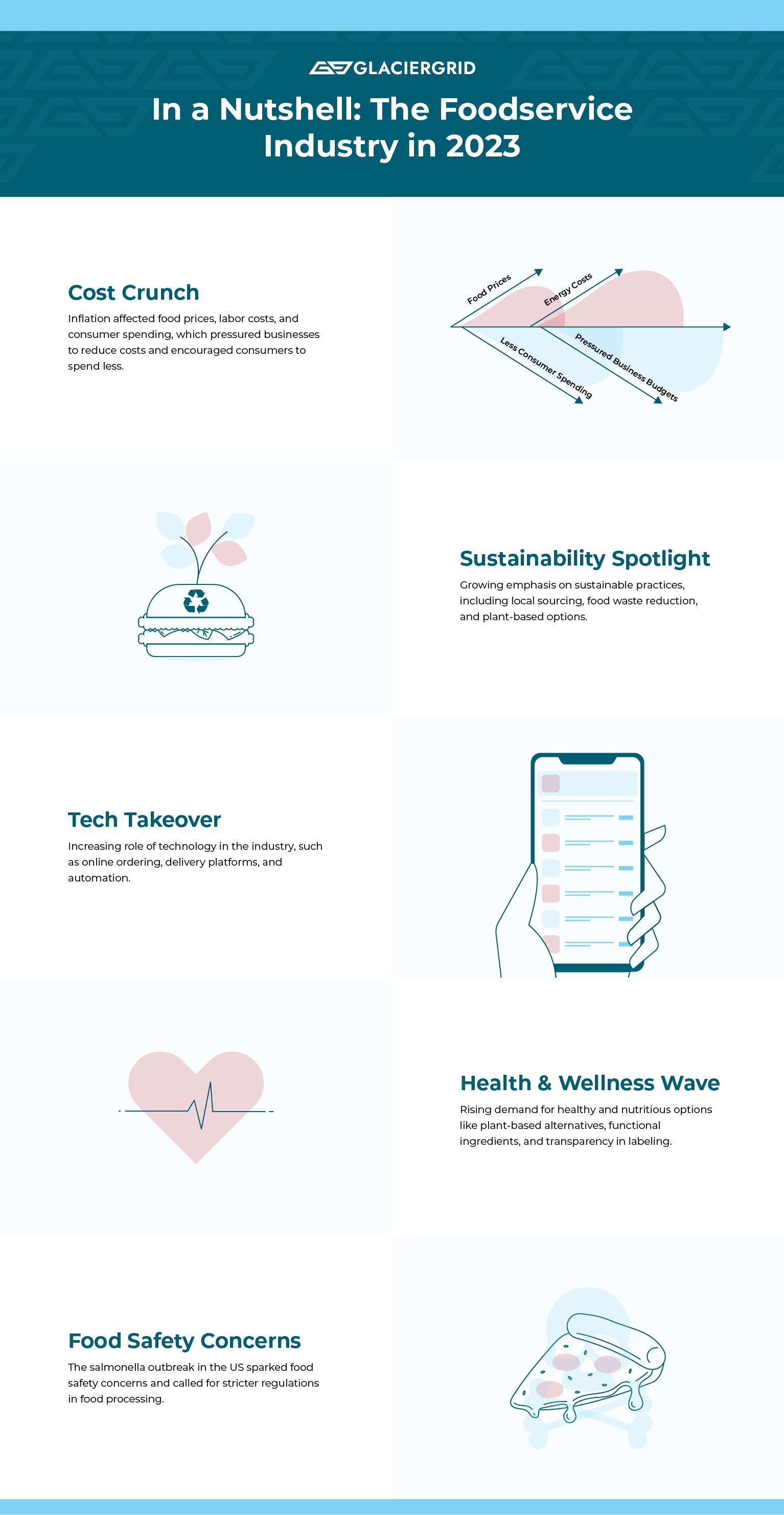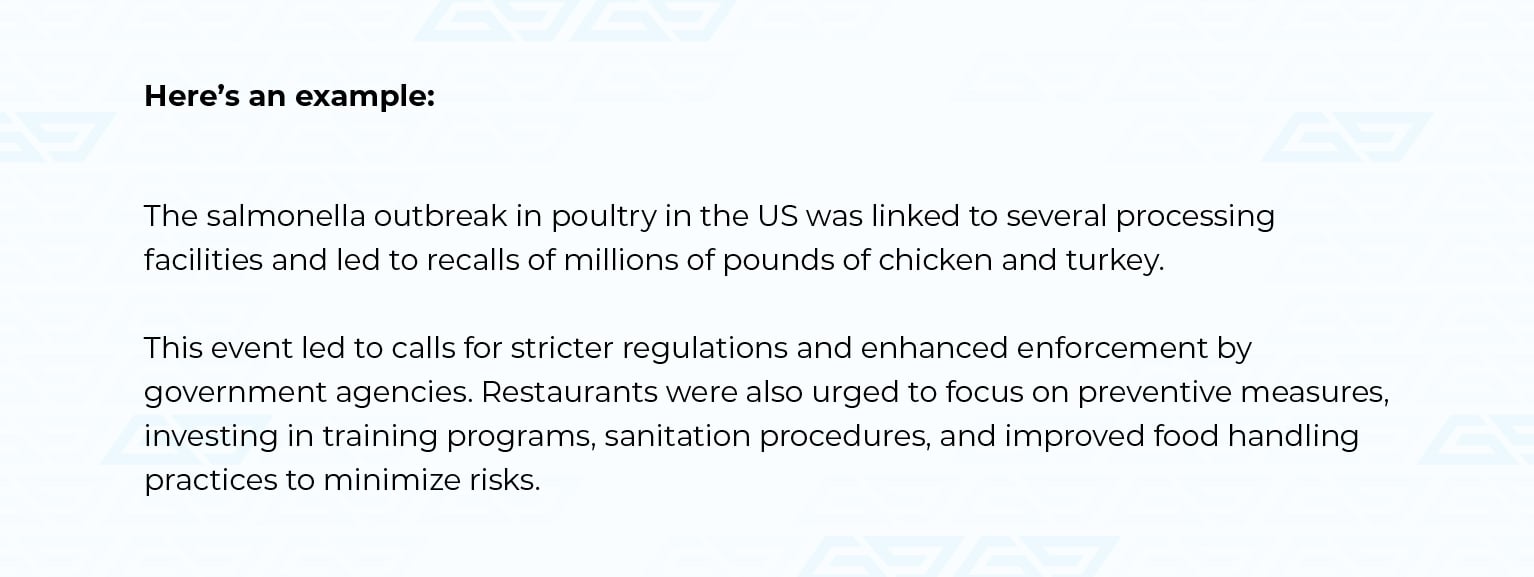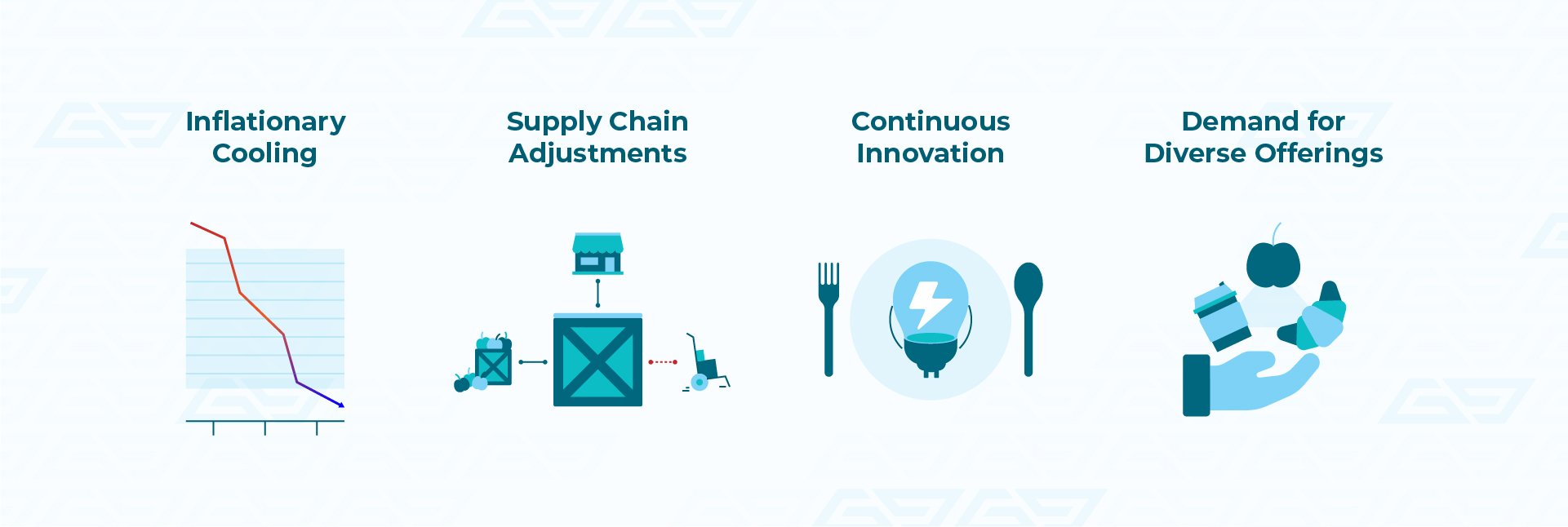Year in Review: 2023 + A Peek at the Menu for 2024 in the Foodservice Industry


Summary of key takeaways
- Supply chains took a massive hit due to ongoing geopolitical tensions, leading to increased costs and shortages of critical commodities.
- Climate change continues to negatively impact the food service industry and the environment. Changes in temperature and rainfall patterns have influenced the global distribution and overall costs of crops.
- Consumers have started leaning towards more budget-friendly food options. Food service businesses must start considering heightened concerns about the health and safety of food, along with a demand for sustainability.
- 2024 will present opportunities for businesses to grow and innovate—with inflation cooling down, much-needed supply chain adjustments, and accessibility of technology designed to optimize restaurant operations.
- Trends from 2023 will carry over to 2024, such as the demand for plant-based alternatives, a focus on health and wellness, and the surge in sustainability-focused demands.
Action Items:
- Invest in sustainability strategies to mitigate operational costs and improve your bottom line.
- Adopt technology that optimizes your restaurant’s operations, like cold storage and HVAC management.
- Source from local vendors to ensure fresh and healthy ingredients. This also minimizes transport costs and caters to health-conscious consumers.
- Train and educate your staff, preparing them to practice sustainability, such as waste management, when operating your establishment.
Introduction: Looking back at a turbulent 2023
Another year, another opportunity to evaluate your business strategies and ensure that everything will be smooth sailing for 2024. However, the best way to do so is by assessing your business’s journey throughout 2023 and various happenings that impacted the foodservice industry as a whole.
1. Global disruptions
The ongoing war in Ukraine disrupted supply chains, increasing input costs and causing shortages of critical commodities like wheat and sunflower oil. Extreme weather events in various regions also impacted crop yields and food security.
Climate change contributed to water scarcity and declining soil quality, threatening agricultural productivity—ultimately leading to higher costs and potential food insecurity. Changes in temperature and rainfall patterns also influence crops' global distribution, affecting the availability of certain ingredients in specific regions.
2. Inflationary pressures
Soaring inflation, driven by energy costs and supply chain disruptions, led to significant price increases for producers and consumers. This squeezed businesses' profits and reduced household disposable income, affecting purchase power for food.
The rise in labor and operational costs for foodservice businesses also pressured their budgets, shifting business focus toward strategies prioritizing efficiency and cost savings.
On the consumer side, inflation led to reduced spending and more value-driven choices. The former refers to customers leaning more towards tightening their belts and eating out less frequently. The latter refers to customers being more budget-conscious and shifting towards cheaper options like fast food, value menus, and take-out instead of full-service dining.
3. Shifts in consumer behavior
With inflation biting, consumers became more budget-conscious, shifting towards private label products and discount retailers. Increased awareness of health and sustainability also influenced purchasing decisions.
Consumers started transitioning to food that promoted overall well-being. This drove demand for dishes rich in fruits, vegetables, whole grains, and lean protein. They also valued transparency about ingredients and origin, pushing restaurants to highlight locally sourced, ethically produced, and organic ingredients.
Restaurants responded by revamping menus to include healthier and more diverse options, incorporating superfoods and functional ingredients. Additionally, some restaurants have started serving smaller portions and healthier alternatives.
As a bonus, smaller portions also mean more manageable food costs, which helps address inflation.
Finally, one of the most significant shifts in consumer behavior is their concern for the environment. Consumers became more conscious of the environmental impact of their food choices, favoring restaurants that adopted sustainable practices.
4. Food safety concerns
Food safety issues raised consumer anxieties, which prompted increased regulatory scrutiny and calls for greater transparency in food production and processing. The help of media covering foodborne illness outbreaks and recalls and increased public access to information through social media amplified awareness of potential food safety risks.

2024: Opportunities for stabilization call for cautious optimism

While 2023 was a hectic rollercoaster for the foodservice industry, the food industry in 2024 is cautiously optimistic. While some challenges remain, there are signs of potential stabilization and even growth:
1. Inflationary cooling
While inflation isn't expected to disappear overnight, it will decline gradually in 2024, easing pressure on consumers and businesses. There are several reasons behind the inflation slowdown:
| Breakdown | What it Means | Impact on the Industry |
| a. Tightening monetary policy | The Federal Reserve raised interest rates aggressively throughout 2023. |
|
| b. Easing supply chain policy | Global supply chains began to normalize after pandemic disruptions. |
|
| c. Cost relief | The slowdown in inflation relieved foodservice businesses facing soaring costs for ingredients, labor, and operational expenses. |
|
| d. Consumer confidence boost | With prices receding, consumers are more comfortable to dine out. |
|
| e. Shifting focus | Consumers shifting their attention from price sensitivity towards other factors like dining experience, healthy options, and sustainability. |
|
2. Supply chain adjustments
Ongoing adaptations and diversification within supply chains should improve stability and reduce businesses’ vulnerabilities to disruptions. These adjustments will bring the following positive impacts to the table:
| Adjustment | What it Means | Impact on the Industry |
| a. Improved logistics | Streamlined transportation routes, optimized warehousing, and better forecasting can reduce inefficiencies and transportation costs. |
|
| b. Greater transparency | Enhanced traceability systems and information sharing across the supply chain. |
|
| c. Diversification of sourcing | Exploring local and regional suppliers alongside traditional channels, investing in alternative ingredients, or finding domestic substitutes for previously imported products. |
|
| e. Adoption of technology | Utilizing automated inventory management systems, AI-powered procurement tools, and data analytics. |
|
| f. Strengthened supplier relationships | Closer supplier collaboration fosters open communication, joint problem-solving, and proactive planning for potential disruptions. |
|
| g. Improved food quality and safety | Consistent access to fresh, high-quality ingredients allows restaurants to maintain or elevate their food quality. |
|
| h. Greater menu transparency | Knowing the origin and journey of their food can resonate with environmentally and ethically conscious consumers. |
|

Need a guide to protect your business from the supply chain crisis?
3. Continuous innovation
Technological advancements and data-driven approaches offer even more efficiency gains and cost-reduction opportunities.
| Innovations | What it Means | Impact on the Industry |
| a. Personalized dining | Visualize AI-powered recommendations, smart menus that adapt to customers’ preferences, and virtual reality dining experiences. |
|
| b. Frictionless service | Automated kiosks, voice-activated ordering, and contactless payment systems will deliver convenience and speed. |
|
| c. Delivery and take-out reinvented | Advanced drones and robots, interactive packaging, AI-powered food prep robots, and personalized meal kits could revolutionize delivery. |
|
| d. Automated kitchens | Businesses can utilize robotic chefs and innovative kitchen tools to handle repetitive tasks. |
|
| e. Inventory management and waste reduction |
AI-powered systems can optimize inventory levels and predict demand. Additionally, apps can connect restaurants with food banks and shelters while upcycling leftover ingredients into new dishes. |
|
| f. Energy optimization | Leveraging smart appliances, data-driven energy management systems, energy-efficient equipment, and renewable energy sources. |
|
| g. Traceability and sourcing transparency | AI-powered platforms can track ingredients from farm to table. |
|
| h. Sustainable packaging and delivery | Businesses are investing in biodegradable packaging materials and electric delivery vehicles. |
|
| i. Upskilling and reskilling programs | Businesses are utilizing advanced workplace technologies and focusing on employee well-being and development. |
|
| j. Data-driven decision-making | Operators are utilizing analytics and performance dashboards and tools. |
|
4. Demand for diverse offerings
Consumer preferences for healthy, sustainable, and convenient food options are expected to remain strong, creating opportunities for businesses that can cater to these demands.
| Offerings | What it Means | Impact on the Industry |
| a. Global culinary journeys | Restaurants will offer authentic flavors from various cultures, catering to adventurous palates and fostering cultural exchange. |
|
| b. Leveraging local vendors | Restaurants will focus on sourcing their ingredients from local farms and producers. |
|
| c. Catering to dietary needs | Restaurants that create diverse menus catering to various dietary needs will attract wider customer bases and build loyalty among those with specific dietary restrictions. |
|
| d. Transparency and education | Customers increasingly value transparency about ingredients, nutritional information, and sourcing practices. |
|
| e. Minimizing environmental impact | Restaurants will commit to reducing food waste, using sustainable packaging, and embracing energy-efficient practices. |
|
| f. Building community and collaboration | Businesses can partner with local farmers, support community gardening initiatives, and offer educational programs about sustainable food practices. |
|
Uncertainties to watch out for in 2024
While these signs of positive development for the foodservice industry are encouraging, businesses should remain vigilant. There are still factors you’ll need to consider when developing your business’s strategies moving forward heavily.
Challenge 1: Geopolitical tensions
In addition to the ongoing war in Ukraine, other global conflicts could continue to disrupt supply chains and cause price volatility.
Examples of geopolitical issues to look out for:
- Ongoing trade tensions between major economies can disrupt the flow of food products and ingredients, leading to shortages, price fluctuations, and unpredictable delivery schedules.
- Conflicts and geopolitical uncertainties in vital food-producing regions can disrupt production and transportation, impact the availability of certain ingredients, and potentially cause price hikes.
- Political tensions can lead to increased scrutiny at borders and delays in shipping, increasing road freight costs by 7% globally (with an expected additional 5% in 2023) and impacting the freshness and timeliness of deliveries.
Challenge 2: Ongoing impacts of climate change
Concerns regarding climate change are on a steady and consistent rise, with its negative impact on the foodservice industry’s ecosystem still prominent.
Examples of ways climate change can still impact your business:
- Crop failure rates will rise by an average of 3.49%—translating to a global loss of roughly 10.72 million acres of cropland.
- Increased frequency and intensity of extreme weather events can lead to higher insurance premiums for foodservice businesses—impacting their bottom line. Disaster preparedness and adaptation become crucial expenses.
- Climate change concerns would require your business to implement responsible waste management practices, compost initiatives, and energy-efficient operations to minimize environmental impact while potentially adding operational costs.
Challenge 3: Rising labor market costs
Increasing labor costs and potential worker shortages could further pressure businesses.
- With increased competition for skilled workers, foodservice businesses will likely face pressure to raise wages, squeeze profit margins, and impact menu pricing.
- High turnover rates (twice the national average at 5.4% for foodservice labor) due to low wages, lack of benefits, and demanding work environments further increase costs through hiring and training expenses.
- With limited staff, streamlining menus and focusing on more straightforward dishes can ensure operational efficiency and maintain quality control.
- Automation and labor-saving technologies might reduce reliance on employees, but initial investments and potential displacement concerns need careful consideration.
2023 trends that will roll over to 2024
Finally, you’ll need to consider the trends in 2023 that generated enough sticking power to carry over to 2024. Here are the notable trends your business will need to take note of moving forward in 2024:
1. Plant-based dominance
- Plant-based meat and dairy alternatives continued their meteoric rise, with market share and investment increasing by 20.4% in 2023 compared to 2022.
- The market for plant-based substitutes reached $42.86bn in 2023—a 7.82% increase from 2022.
- Major restaurant chains and food brands expanded their plant-based offerings to cater to growing consumer demand.
2. Sustainability surge
- In a 2023 Earth Day Survey conducted by Kearney, 42% of consumers have sustainability at the top of their minds when buying food.
- Local sourcing, organic farming, and reduced food waste became important purchase factors.
- Regenerative agriculture and carbon-neutral practices gained momentum as ways to lessen environmental impact.
3. Convenience craze
- The ready-to-eat food market reached USD 395.9 billion in 2023 and is projected to grow at a CAGR of 6.8% until 2030.
- Grocery stores expanded prepared food sections and offered subscription services for added convenience.
4. Health and wellness focus
- Consumers prioritized health and wellness, driving demand for functional foods, probiotics, and personalized nutrition options.
- The sugar-free food and beverage market size is expected to grow from USD 19.17 billion in 2023 to USD 23.30 billion by 2028, at a CAGR of 3.98%.
- Transparency in labeling and ingredient sourcing became increasingly important.
5. Technological innovation
- Technology continued to reshape the food industry with agriculture, food processing, and retail advancements.
- Artificial intelligence and robotics played a more prominent role in optimizing production, reducing waste, and enhancing personalization.
- E-commerce platforms and on-demand delivery services further solidified their hold on the market.
6. Other notable trends
- Rise of "ugly" fruit and vegetable initiatives to reduce food waste. This is when businesses promote produce that don’t meet cosmetic standards but are just as nutritious and tasty as their more visually appealing counterparts.
- Multicultural populations fuel the growing popularity of ethnic and international cuisines.
- Experimentation with alternative proteins like insects and lab-grown meat.
Sustainability will pave the way for long-term profitability
2023 wasn’t pulling any punches, throwing significant developments such as geopolitical tensions, inflation, and consumer demand shifts at the foodservice industry. While these developments presented many challenges for foodservice businesses, they also opened opportunities for businesses to innovate and take advantage of smart solutions to re-establish a strong foothold in 2024.
GlacierGrid, for example, remains passionate in our advocacy to assist foodservice businesses in achieving profitability and sustainability using cutting-edge energy-efficient technologies and strategies.
Businesses must consider adapting more sustainable strategies to mitigate operational costs and appeal to the current consumer market. Sustainability has proven to be more than just a passing trend—it’s necessary in today’s climate for businesses aiming for long-term success in the industry.
Additional Resources:
“Unilever is Rethinking Ice Cream to Reduce Emissions and Energy Costs” (GlacierGrid)—This article highlights how even a big brand such as Unilever is making innovations to promote sustainability.
“6 Practical Ways to Reduce Food Waste” (GlacierGrid)—This article provides a step-by-step guide on how you can start reducing food waste in your restaurant.
“Russia, Ukraine, and Global Food Security: A One-Year Assessment” (Center for Strategic & International Studies)—This article provides insights into the war's impact on food production, trade, and access, highlighting its potential consequences for global food prices and security.
"How Climate Change is Disrupting the World's Food Supply" (The Guardian)—This article explains how climate change negatively impacts global food security and why it’s imperative for a collective effort to mitigate these climate-induced disruptions.
“4 Sustainability Tips to Maximize Restaurant Profitability for 2024”—This article provides actionable tips for your business to optimize your restaurant operations.
“Good Food Institute State of Alternative Protein 2023”—This report analyzes the rapidly growing plant-based and alternative protein market, highlighting its impact on consumer choices and restaurant offerings in 2023.








